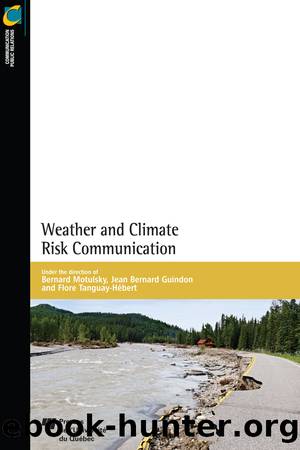Weather and Climate Risk Communication by Motulsky Bernard;Guindon Jean Bernard;Tanguay-Hébert Flore;

Author:Motulsky, Bernard;Guindon, Jean Bernard;Tanguay-Hébert, Flore;
Language: eng
Format: epub
Publisher: Presses de l'Université du Québec
8.1SCIENTIFIC LIMITATIONS
Meteorological and climate risk communication takes place in a complex, multidimensional environment. Meteorologists and climatologists from around the world strive to better understand and predict atmospheric phenomena. Supported by the most advanced technology, scientists share basic and applied knowledge which allows us to best handle atmospheric fluctuations in our surroundings.
Although meteorology and climatology specialized areas are often considered to be similar, they involve different atmospheric perspectives. Meteorologists focus on short-term atmospheric variations. Their forecasts influence peopleâs clothing and transportation choices. Certain applications assist farmers in planning their operations while others that are more specialized, contribute to air and marine navigation and safety.
Climatologists focus on climate variations, namely long-term atmospheric fluctuations. Their predictions influence planning with land developers, urban planners, and engineers. Many political decision-makers are impacted as well as standards and regulatory organizations. Climatologists also influence financial institutions, insurance companies, transportation and construction companies. The study of atmospheric variations clearly affects many aspects of our lives and our societies.
Both climatology and meteorology leverage other disciplines such as mathematics, physics, astronomy, biology, hydrology, and computer science, to enhance analysis and forecasts. The study of meteorological and climate phenomena, their related hazards and risks is based on multidisciplinary approaches. Although the convergence and synergy are positive, a more in-depth review of the incidence is called for. More precisely defining, the concepts is an example.
Environment, risk, storm, and disaster are concepts with different definitions based on the discipline, institution, and even the researcher. The definition of the concepts has great importance in overall communications and particularly in risk communication. Effort is still needed to reach a consensus on the concepts and ensure consistent messaging. Scientific uncertainties add to the challenge of defining the concepts, which vary in nature and importance depending on the phenomena observed.
First, uncertainties related to meteorological phenomena will be reviewed. These uncertainties develop with precipitation (snow, sleet, freezing rain, rain), as well as with their probability, quantity, and distribution. Gaps related to these uncertainties often reside with the publicâs ability to adapt. This is not the case for storm predictions. Uncertainties associated with storms negatively impact the adoption of cautious behaviours. Although we can accurately predict cold waves and strong winds, it is still currently not possible to predict a tornado, one of the most violent meteorological events.
Climate uncertainties also create major risk management issues. First of all, this is because climate phenomena develop over long periods of time, which makes it difficult for a layperson to see the cause-and-effect relationship. As well, some people do not believe in global warming while others do not believe climate change is caused by humans. We need to overcome these uncertainties to ensure that structured adaptation measures are adopted in respect to our dependence on fossil fuel, our societyâs choices in land-use development and construction standards.
Psychosociological uncertainties are also added to the climate and meteorological uncertainties and explain the gaps in perception of risks and adoption of behaviours to reduce vulnerability. Psycho-sociological aspects also significantly influence tolerance to risk and its indicator of acceptable risk.
Download
This site does not store any files on its server. We only index and link to content provided by other sites. Please contact the content providers to delete copyright contents if any and email us, we'll remove relevant links or contents immediately.
CCNA Cisco Certified Network Associate Exam (200-301): Technology Workbook by IP Specialist(494)
Learning First, Technology Second by Liz Kolb(477)
Passionate Readers by Pernille Ripp(465)
Presenting: The Professor's Guide to Powerful Communication by Norman Eng(461)
The SEO Book: Search Engine Optimization 2020, Free SEO Audit incl., Way to Nr. 1, SEO and SEM by Tobias Ebner & Granitza Levin(424)
Guide to Teaching Computer Science by Orit Hazzan Tami Lapidot & Noa Ragonis(398)
Google Classroom: 2019 User Manual to Learn Everything You Need to Know About Google Classroom by Class Alexa(381)
The Math(s) Fix: An Education Blueprint for the AI Age by Wolfram Conrad(365)
Web-Based Learning by Gayle V. Davidson-Shivers Karen L. Rasmussen & Patrick R. Lowenthal(345)
Advanced Apple Debugging by 2018(344)
Research on Mathematics Textbooks and Teachers’ Resources by Lianghuo Fan Luc Trouche Chunxia Qi Sebastian Rezat & Jana Visnovska(344)
Guide to Teaching Puzzle-based Learning by Edwin F. Meyer Nickolas Falkner Raja Sooriamurthi & Zbigniew Michalewicz(314)
Video in the Age of Digital Learning by Jonas Köster(308)
Computational Thinking in the STEM Disciplines by Myint Swe Khine(302)
Creativities, Technologies, and Media in Music Learning and Teaching (Oxford Handbooks) by Gary E. McPherson & Graham F. Welch(297)
Digital Workplace Learning by Dirk Ifenthaler(297)
Digital Tools in Urban Schools: Mediating a Remix of Learning by Mahiri Jabari(271)
Deeper Learning With QR Codes and Augmented Reality by Monica Burns(264)
Best Technologies for Public Libraries by Christopher DeCristofaro(261)
